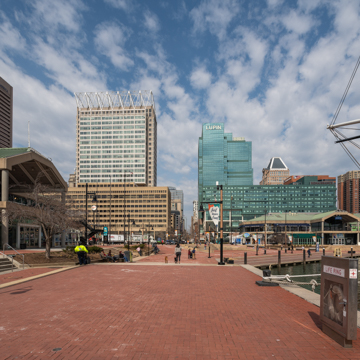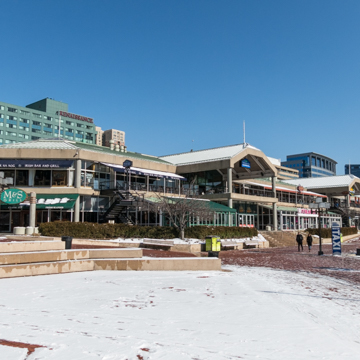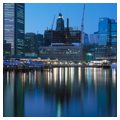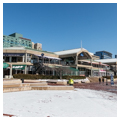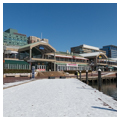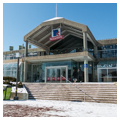While efforts to reshape the Inner Harbor into a modern commercial district had been underway for years, it was the opening of Harborplace in 1980 that transformed this former industrial landscape into a tourist destination. Developer James Rouse initiated the “festival marketplace” concept at Faneuil Hall/Quincy Market in Boston before bringing this successful urban redevelopment strategy to his home state of Maryland. With Harborplace, Rouse was seen as an urban savior, appearing on the cover of Time magazine in 1981 with the headline “Cities are Fun!” Arranged perpendicularly, each long two-story pavilion has inner and outer retail arcades, with spaces for stores, market stalls, cafés, and restaurants. While architecturally Harborplace resembles any number of the suburban shopping centers developed by Rouse and others, it also recalled the older urban market forms and represented a pathbreaking willingness to invest in inner city redevelopment at a low point in urban living.
Here the existing Baltimore public markets were bypassed to create a reimagined market experience in entirely new buildings. The space at the corner of Light and E. Pratt Streets between the two pavilions became a public plaza and amphitheater that facilitated circulation between the business district and the waterfront. Rouse’s vision for festival marketplaces rather idealistically included local retailers re-creating the small-scale capitalism he viewed as the heart of urban life. Initially Harborplace did house some local businesses, but this popular destination quickly became dominated by national chains.
Thompson and Rouse went on to build more festival marketplaces, including South Street Seaport in New York City and Riverwalk in New Orleans. While these projects initially proved to be quite successful, the tenants tended to be major national chains and the overall atmosphere much like the suburban mall. Even as accusations of inauthenticity and questionable benefit to local business dogged Harborplace and other festival marketplaces, they were widely recognized as effective late-twentieth-century down-town redevelopment tools. Sold by the Rouse Company in 2003, Harborplace continues to draw Inner Harbor tourists.
References
Bloom, Nicholas Dagen. Merchant of Illusion: James Rouse, America’s Salesman of the Businessman’s Utopia. Columbus: The Ohio State University Press, 2004.
Hayward, Mary Ellen, and Frank R. Shivers, Jr., eds. The Architecture of Baltimore: An Illustrated History. Baltimore: Johns Hopkins University Press, 2004.
Millspaugh, Martin L. “The Inner Harbor Story.” Urban Land (April 2003): 36-41.
Olsen, Joshua. Better Places Better Lives: A Biography of James Rouse. Washington, D.C.: Urban Land Institute, 2003.


